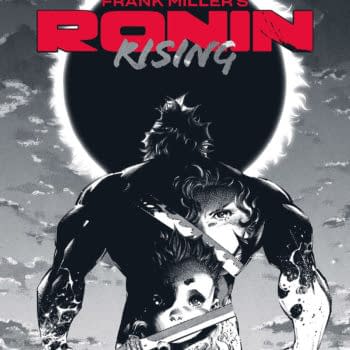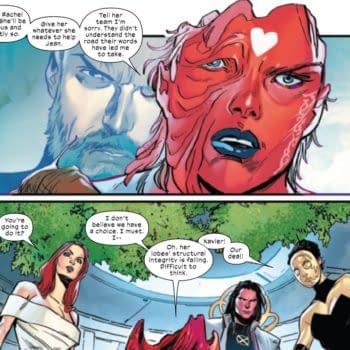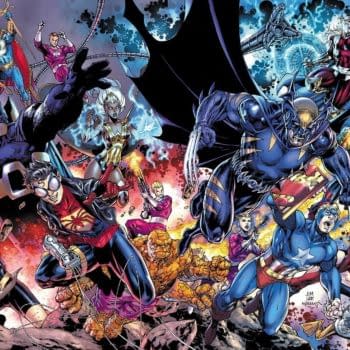Posted in: Comics, Review | Tagged: beautiful canvas, black mask, HRL, ryan ferrier, Ryan K. Lindsay, Sami Kivelä, Triona Farrell
Beautiful Canvas #1 Review: Crimes Of Sound And Fury Signifying Nothing

Beautiful Canvas is a new crime (ish?) comic out this week from Black Mask Studios. I say "crime-ish" since it seems to have a crime story at the heart of it, buried as it is under a few layers of super powers, made-for-TV-movie characters and baffling dialog choices. (Seriously, can anyone tell me what "cloak my scarf" means? Urban dictionary has not helped at all.)
I had a lot of reactions and responses to Beautiful Canvas #1 as I was reading it, and not many of them were positive. One line that kept running through my head as I turned through page after page of over the top, near cartoon villainy merged with inexplicable monster people, in conjunction with graphic violence and a lesbian love story was, "I know Stray Bullets and you sir, are no Stray Bullets."
To be honest, it's kind of nice to see a comic so clearly aping David Lapham, as the modern comic luminaries who obviously inspire the work of newer creators seem to be usually limited to Grant Morrison, Warren Ellis, or Bendis (just one name, like Prince or Madonna).
I just don't know what Philip K. Dick has to do with anything. There is a fair amount of space towards the end of the comic in a little post-comic column dedicated to the writer (Ryan K. Lindsay) conversing with his editor (Dave Hill) about Dick and Lindsay mentions him, as well. Not to sound like a broken record, but I know the work of Philip K. Dick, and you, sir…
OK, that's a little unfair, as the message that Lindsay seems to be putting forth is not that this is attempting to be a Phil Dickian story, but that it's inspired by his work — I think. At one point in the comic, the hilariously named Milla Albuquerque calls her cinematographer/hit man/lackey a "wannabe Lynch shitweasel." I don't think that line was supposed to come off as meta as it does.
The story is simple enough: professional assassin Lon Eisley kills a vegetarian coke-head and ends up taking under her wing a young boy, the only witness to the Kill Bill-inspired hit that just robbed him of his terrible mother. Then there's a sort of trippy aside to what at first glance appears to be an abandoned amusement park, but might actually be some kind of digital mind cell? The point of this aside is to discover that a grungy bad boy type wants revenge on the absurd-in-name-and-behavior Milla Albuquerque. Meanwhile, Lon and her child charge are now being hunted by a literal monster squad. And there's a surprise at the end of the book that makes up for a lot of the weaker points of the narrative, though I'm not sure if it's enough to make me want to invest myself in the rest of the story.
Beautiful Canvas #1 begins with this beautifully done, graphically horrifying page of Lon, some bodies, and some surreal, haunting type, post-carnage mind-messing, but then never refers to it again. Maybe (I mean, probably) they will in a later issue — this is some kind of backstory building tease — but this is a first issue. You can't be all tease in a first issue. As it stands, I don't care what that scene was all about, or why it haunts Lon or what she's overthinking, or who is actually saying that, because I don't really care about Lon yet.
(Edit: I see now that we do get more references to this scene throughout Beautiful Canvas #1, in addition to revealing the origin of the blood-covered ghost girl. Still, connecting multiple chronologies in a narrative is difficult work. You run the risk of baffling your audience, who can't really catch on to what's actually happening because you haven't made it clear enough, while the past and present look WAY too much alike to be easily distinguishable.
We get that Lon sees a ghost girl covered in blood (and bullet holes?), so it's some kind of haunting past trauma that she lives with. This opportunity now with this new living child is a chance to rewrite her old failings and lose the ghosts that haunt her.
Milla's monologuing is so disastrously bizarre, but it's meant to be…I don't know! Profound? Frightening in an eerie villain-y kind of deep, weird way? What do you make of this line:
"Art, love, fruit, sex, revenge, beauty–they all require exact preparation for far longer than that single apex moment when they become what you wanted them to be."
Read it again. One of those things is not like the others, one of those things does not belong. How do you have five seemingly random concepts and then, fruit? Not even "food" or something else that could sort of be stretched into the conceptual realm, but "fruit". Oh, and in the scene she's "gardening", which means cutting off the limbs of a dude on a rack and putting them in potted dirt and watering them in a slinky red dress while talking blue and tough.
I just don't understand what this book is trying to do, or say, or who any of these characters are, or what motivates them beyond some really bad-seeming baddie who says things like, "When I flap my hands, you talk like I'm inches up your ass, okay?"
Which, while we're here, what the hell does that even mean? Flap my hands? Does some of this dialogue sound like it was written by a computer that got fed like 30 Joe Eszterhas scripts and doesn't actually understand the words it's using? Also, how would someone talk with someone inches up their ass? Like, through gritted teeth, maybe? Wouldn't that make communication more difficult? I'd imagine you'd want to remove yourself from said ass before beginning a meaningful dialogue.
There's way too much backmatter for a comic that isn't Criminal or by Alan Moore. I didn't even realize the fake newspaper in the back was actually tied into this comic until my third reread, because, again, it's not obvious. You'd have to really think hard to remember that the guy in that tiny scene on the trippy amusement park ride, who was the grungy bad ass, is called "Eric" once by the bespectacled suit. If you don't remember that, you're not going to know that you're supposed to read this paper to figure out what happened to him…or something.
Granted, Beautiful Canvas isn't all bad. The dialogue between Lon and Asia is really great. It reminded me of times in the past when I've talked with people I loved and who loved me back. That was kind of a nice surprise feeling to get stirred up. The emotional energy between those two characters feels like the only thing in the book that is actually honest and real and not weird, tough guy posturing or pointlessly violent cartoonish sexual anger-speech.
All and all, Beautiful Canvas #1 is not a first issue that made me want to read more. I found it to be trying real hard to come across as some Warren Ellis-y, psychosexual, future shock superpowers narrative. The art was good, though perhaps too homogeneous throughout the book; changing styles would've helped keep the various locales and timelines separate and easier to follow.
The relationship between Lon and Asia would be enough to carry me on to issue #2, as well as the surprise at the end; however, that's not a strong endorsement from me, as I get very worn out very quickly by foul-mouthed toughs these days. And Beautiful Canvas #1 doesn't have much more going for it beyond that.













